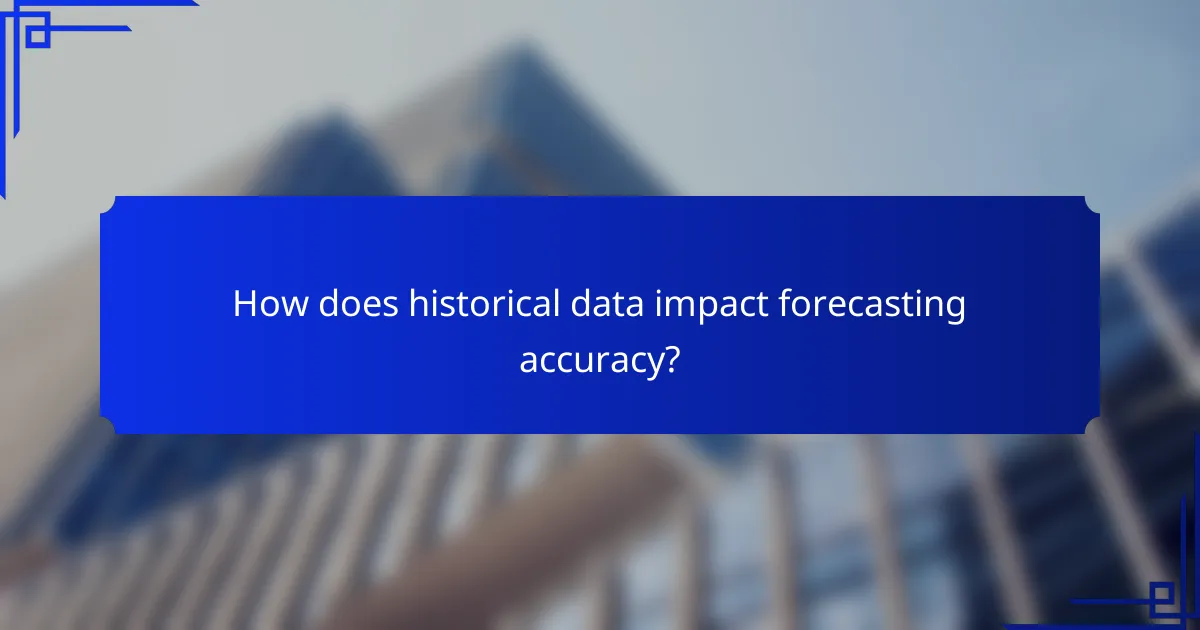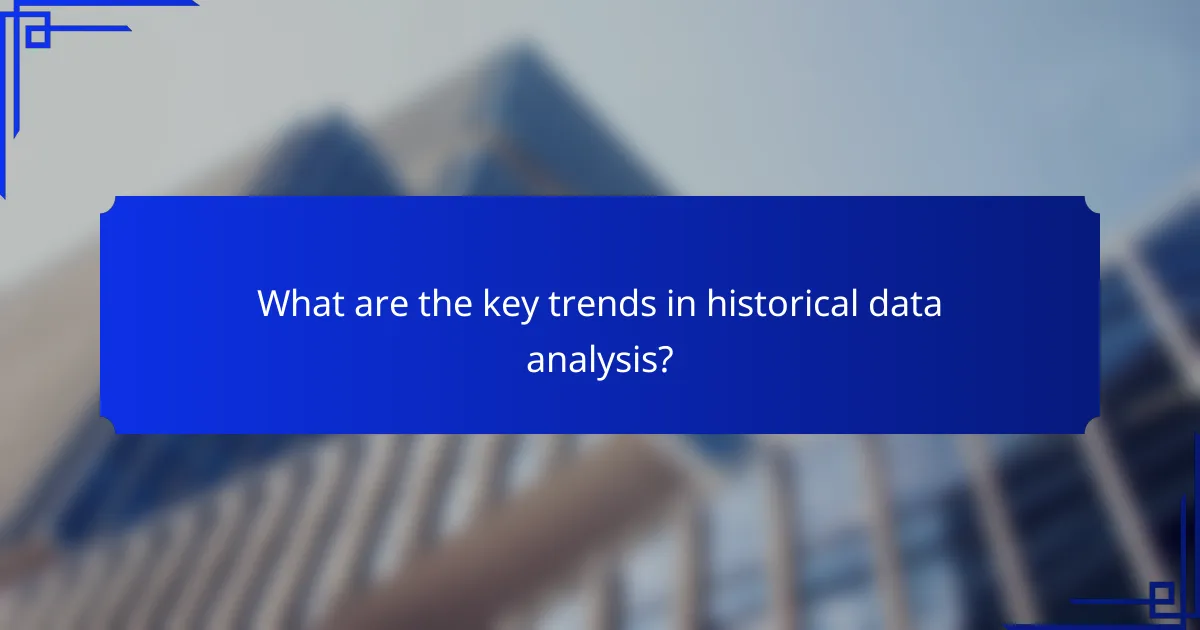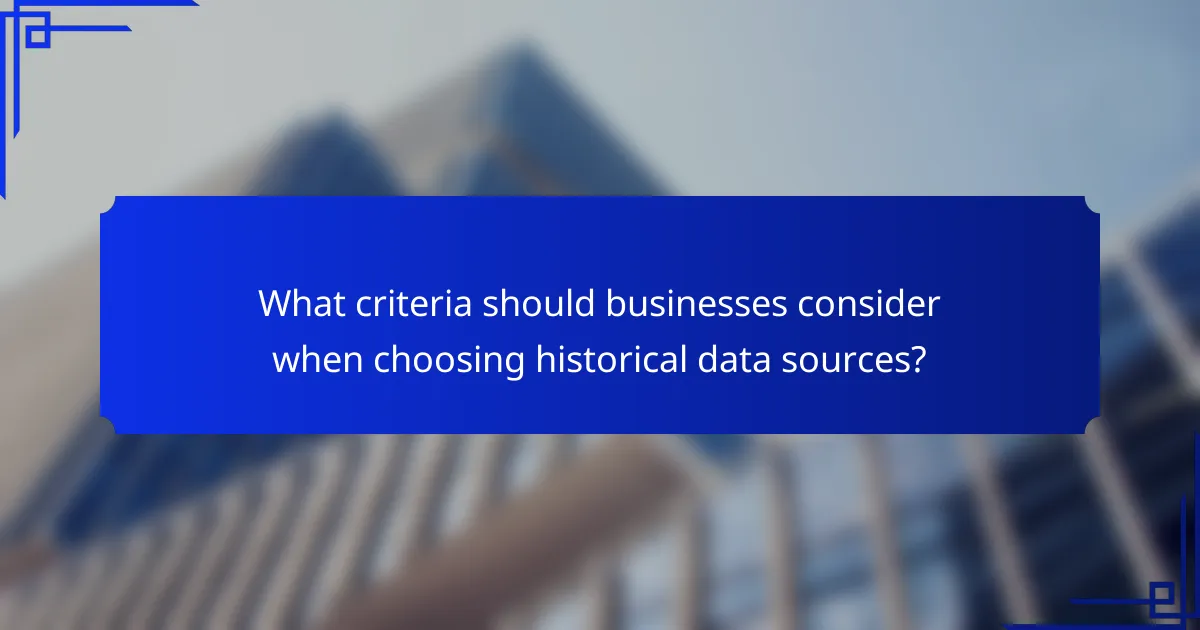Historical data plays a crucial role in improving forecasting accuracy by offering insights into past performance and trends. Organizations that effectively analyze this data can make informed predictions about future outcomes, leading to enhanced strategic decision-making and operational optimization.

How does historical data impact forecasting accuracy?
Historical data significantly enhances forecasting accuracy by providing a foundation of past performance and trends. By analyzing this data, organizations can make informed predictions about future outcomes, leading to better strategic decisions.
Improves predictive models
Historical data is crucial for developing predictive models, as it allows analysts to identify patterns and relationships within the data. By utilizing techniques such as regression analysis or machine learning, businesses can create models that reflect past behaviors and forecast future trends with greater precision.
For example, a retail company might analyze sales data from previous years to predict future sales during holiday seasons. This approach can lead to more accurate inventory management and better customer satisfaction.
Identifies trends over time
Analyzing historical data helps organizations identify long-term trends that may not be apparent in short-term data. Recognizing these trends allows businesses to adapt their strategies and operations proactively.
For instance, a manufacturing firm could track production efficiency over several years to spot improvements or declines, enabling them to implement necessary changes before issues escalate. This trend analysis can also inform market positioning and product development strategies.
Enhances decision-making
Access to historical data empowers decision-makers by providing evidence-based insights. This information allows leaders to evaluate the potential impact of their choices and to mitigate risks associated with uncertainty.
For example, a financial institution might use historical data on loan defaults to refine its risk assessment models, leading to more informed lending decisions. By relying on data rather than intuition, organizations can enhance their overall effectiveness and competitiveness.

What are the key trends in historical data analysis?
Key trends in historical data analysis include the increasing reliance on advanced technologies like AI and machine learning, the shift towards real-time data integration, and a growing emphasis on data visualization tools. These trends significantly enhance the accuracy and usability of historical data for forecasting and decision-making.
Increased use of AI and machine learning
The integration of AI and machine learning in historical data analysis allows for more sophisticated pattern recognition and predictive modeling. These technologies can analyze vast datasets quickly, identifying trends that might be missed by traditional methods.
For instance, machine learning algorithms can improve forecasting accuracy by continuously learning from new data inputs. Businesses can leverage these insights to make informed decisions, optimize operations, and enhance customer experiences.
Shift towards real-time data integration
Real-time data integration is becoming essential for organizations aiming to stay competitive. This trend enables businesses to access and analyze data as it is generated, allowing for immediate insights and timely decision-making.
For example, retail companies can adjust inventory levels based on current sales trends, while financial institutions can monitor market changes in real-time. This agility helps organizations respond swiftly to market demands and reduces the risk of outdated information impacting strategies.
Focus on data visualization tools
Data visualization tools are increasingly important in historical data analysis as they transform complex datasets into understandable visual formats. Effective visualizations help stakeholders grasp insights quickly and facilitate better communication of findings.
Tools like Tableau and Power BI allow users to create interactive dashboards that highlight key trends and anomalies. By utilizing these tools, organizations can enhance their reporting capabilities and ensure that data-driven insights are accessible to all team members.

How can businesses leverage historical data for growth?
Businesses can leverage historical data to identify trends, optimize operations, and enhance decision-making, ultimately driving growth. By analyzing past performance, companies can make informed predictions and strategic adjustments that align with market demands.
Optimizing inventory management
Utilizing historical data allows businesses to forecast inventory needs more accurately, reducing excess stock and minimizing shortages. By analyzing sales trends and seasonal fluctuations, companies can adjust their inventory levels accordingly, ensuring they meet customer demand without overstocking.
For instance, a retailer might find that certain products sell better during specific months, allowing them to increase stock ahead of peak seasons. Implementing just-in-time inventory practices can further enhance efficiency and reduce holding costs.
Enhancing customer segmentation
Historical data can significantly improve customer segmentation by revealing patterns in purchasing behavior and preferences. Businesses can analyze past transactions to identify distinct customer groups, tailoring marketing efforts to meet the specific needs of each segment.
For example, a company may discover that younger customers prefer online shopping while older customers favor in-store experiences. This insight allows businesses to create targeted campaigns that resonate with each demographic, enhancing customer engagement and loyalty.
Improving marketing strategies
By leveraging historical data, businesses can refine their marketing strategies to be more effective and cost-efficient. Analyzing past campaign performance helps identify which channels and messages yield the best results, allowing for optimized budget allocation.
For instance, if a business finds that email marketing campaigns resulted in higher conversion rates compared to social media ads, they can focus more resources on email outreach. Regularly reviewing and adjusting strategies based on historical insights ensures continuous improvement and maximizes return on investment.

What criteria should businesses consider when choosing historical data sources?
Businesses should evaluate historical data sources based on reliability, relevance to their objectives, and the cost of acquisition. These criteria ensure that the data used for analysis and forecasting is accurate, applicable, and financially viable.
Data reliability and accuracy
Data reliability and accuracy are crucial for making informed business decisions. Reliable data sources are those that consistently provide correct information over time, while accuracy refers to how close the data is to the true values. Businesses should consider data from reputable providers, peer-reviewed studies, or government databases to ensure high standards.
To assess reliability, look for sources that have been validated by independent audits or have a track record of accuracy. Regular updates and transparency in data collection methods also enhance trustworthiness.
Relevance to business objectives
Choosing data sources that align with specific business objectives is essential for effective analysis. Historical data should provide insights that directly inform strategic decisions, such as market trends, customer behavior, or operational efficiencies. For example, a retail business may prioritize sales data from its own stores over broader industry reports for more actionable insights.
Consider the time frame and context of the data as well. Data that is too old or not specific to your market may lead to misguided strategies. Tailor your data selection to fit the unique needs of your business goals.
Cost of data acquisition
The cost of acquiring historical data can vary significantly depending on the source and the depth of information required. Businesses should weigh the potential benefits of the data against its cost to determine if it fits within their budget. Free or low-cost sources may suffice for preliminary analysis, while more comprehensive datasets might justify higher expenses.
Additionally, consider the long-term value of the data. Investing in high-quality data that yields actionable insights can lead to greater returns over time. Always evaluate whether the data acquisition cost aligns with the expected outcomes and benefits to your business.

What are the challenges in ensuring historical data accuracy?
Ensuring historical data accuracy involves overcoming several challenges that can compromise the integrity of the data. Key issues include data entry errors, inconsistent data formats, and outdated information, each of which can significantly impact the reliability of historical records.
Data entry errors
Data entry errors occur when information is incorrectly inputted into databases, leading to inaccuracies. Common mistakes include typos, miscalculations, and incorrect data selection. To minimize these errors, organizations should implement robust validation checks and consider using automated data entry systems.
Regular audits and cross-verification with original documents can help identify and rectify these errors. Training staff on proper data entry techniques is also essential to reduce the likelihood of mistakes.
Inconsistent data formats
Inconsistent data formats arise when historical data is collected from various sources, each using different standards. This can lead to difficulties in data integration and analysis. For example, dates may be recorded in different formats (MM/DD/YYYY vs. DD/MM/YYYY), causing confusion and potential misinterpretation.
To address this issue, organizations should establish standardized formats for data collection and ensure that all data sources adhere to these standards. Utilizing data transformation tools can also help convert data into a consistent format for easier analysis.
Outdated information
Outdated information can skew historical data accuracy, as it may not reflect the current context or conditions. This is particularly problematic in fast-changing fields such as technology or finance, where data can quickly become irrelevant. Regular updates and reviews of historical data are necessary to maintain its accuracy.
Implementing a schedule for data review and updating can help ensure that information remains current. Organizations should also consider the relevance of the data in relation to ongoing trends and changes in their respective industries.

How do different industries utilize historical data?
Different industries leverage historical data to inform decision-making, enhance operational efficiency, and predict future trends. By analyzing past performance, organizations can identify patterns and make data-driven choices that align with their strategic goals.
Finance: risk assessment
In finance, historical data is crucial for risk assessment, helping institutions evaluate potential losses and gains. Analysts often examine past market trends, economic indicators, and financial performance to forecast risks associated with investments.
Key metrics such as Value at Risk (VaR) and stress testing rely on historical data to simulate various market conditions. For example, a bank may analyze the last decade of economic downturns to understand how its portfolio might react in a similar future scenario.
To effectively utilize historical data in risk assessment, financial professionals should focus on maintaining accurate records, regularly updating their datasets, and considering external factors like regulatory changes or geopolitical events that could impact market stability.
